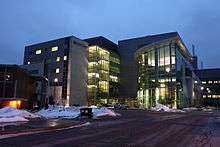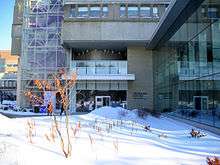McMaster Faculty of Health Sciences
The McMaster Faculty of Health Sciences is one of six faculties at McMaster University in Hamilton, Ontario, Canada. The faculty was established in 1974 to oversee the School of Nursing, the School of Medicine, and Graduate programs in health sciences. Today, the Faculty of Health Sciences oversees 5,000 students, 770 full-time faculty, more than 1,800 part-time faculty, and 28 Canada Research Chairs.[1][2] The faculty is well known for running the most competitive medical and undergraduate program in Canada. The MD program at McMaster University Medical School receives 5000 applications for 203 positions.[3] The BHSc program at McMaster University receives over 3500 applications for 160 positions annually and was ranked the most competitive undergraduate program in Canada by Yahoo Finance in 2016.[4][5] The faculty was ranked 25th in the world in the 2015 Times Higher Education World Rankings in the Clinical, Pre-Clinical and Health category.
 | |
| Established | 1974 |
|---|---|
| Dean | Paul O'Byrne |
| Students | 5,000 |
| Location | , , |
| Website | Faculty of Health Sciences |
Programs

The faculty currently houses the following programs:
- Michael G. DeGroote School of Medicine
- School of Nursing
- School of Rehabilitation Science
- Midwifery Education Program
- Physician Assistant Education Program
- Bachelor of Health Sciences
- Graduate Program in Biochemistry
- Graduate Program in Medical Sciences
- Graduate Program in Global Health
- Graduate Program in Health Management
- Graduate Program in Neuroscience
- Masters in Public Health
- Health Policy PhD Program[6]
- Integrated Biomedical Engineering and Health Sciences[7]
Facilities

The faculty currently operate a number of facilities on the McMaster's main campus and around Ontario for both education and research. The faculty also operates its own library at the university, known as the Health Sciences Library. The Michael G. DeGroote Centre for Learning and Discovery, which houses the faculty's medical school also houses more than 250 scientists and McMaster's medical institutes including, the Centre for Function Genomics, Centre for Gene Therapeutics, Institute for Cancer and Stem Cell Biology Research, Robert E. Fitzhenry Vector Laboratory, Centre for Asthma and Allergy Research (Allergen), the Michael G. DeGroote Institute for Pain Research and Care and North American Headquarters for West Nile studies.[8]
The faculty also operate two regional campuses in St. Catharines, Ontario and Kitchener, Ontario. The campus in Kitchener, known as the Waterloo Regional Campus, shares facilities with the Health Sciences Campus of the University of Waterloo.[9] The campus in St. Catharines is located at Brock University's Niagara Health and Bioscience Research Complex.[10] Approximately 30 medical students in each year of the program attend each campus.[11] Those who apply to McMaster's School of Medicine are asked to rank their site choice (Hamilton, Niagara Region, Waterloo Region) from first to third, or no preference. Offers of admission to the medical school are made from a rank list irrespective of geographical preference. Subsequent to filling the positions, registrants to the class are offered a position based on their preference and geographical background. The offers given out by McMaster are bound to the assigned site.[11]
The faculty is also currently affiliated with two major academic hospital systems, Hamilton Health Sciences and St. Joseph's Healthcare Hamilton. Combined, the two faculties operate ten hospitals in the Hamilton area, each used as teaching hospital by the faculty.[12] Norfolk General Hospital is the latest hospital to be affiliated with the faculty, becoming an affiliated teaching hospital with the university in 2009.[13]
Reputation
In the 2012 Times Higher Education rankings of clinical, pre-clinical, and health universities, the university ranked 16th in the world and 2nd in Canada, behind Mcgill University.[14] The faculty was placed 82nd in the world and fourth in the country in the U.S. News & World Report university rankings for life sciences and biomedicine.[15] In the field of clinical medicine and pharmacy, the ARWU in 2010 ranked the program 51st–75th in the world and third in Canada.[16] In the 2016 Times Higher Education rankings of clinical, pre-clinical, and health universities, the university ranked 27th in the world, and 3rd in Canada, with University of Toronto taking 1st in Canada and 11th in the world, whereas Mcgill University took 2nd in Canada and 20th in the world.[17]
Research
In 2010, the university was ranked by High Impact Universities 25th out of 500 universities—second in the country—for research performance in the fields of medicine, dentistry, pharmacology, and health sciences.[18] For five years in a row, McMaster has ranked second in Canada for biomedical and health care research revenues. In 2008–2009, Faculty investigators were overseeing $133 million a year in research, much of that research conducted by scientists and physicians who teach in the medical school.[19] For its 2010 rankings, HEEACT ranked McMaster 26th in the world and second on a national scale for scientific papers in clinical medicine.[20] The Faculty of Health Sciences operates several research institutes, including the Farncombe Family Digestive Health Research Institute, the DeGroote Institute for Infectious Disease Research, and the Stem Cell and Cancer Research Institute.[21][22][23] In November 2010, researchers at the Stem Cell and Cancer Research Institute turned clumps of human skin into blood cells, which may help alleviate the shortage of blood donors.[24] A portion of Albert Einstein's brain is preserved and held for medical research at the McMaster brain bank. Researchers there have identified differences in his brain that may relate to his genius for spatial and mathematical thinking.[25]
Notes and references
- http://fhs.mcmaster.ca/main/facts.html
- http://fhs.mcmaster.ca/main/research/research_canada_chairs.html
- "Class of 2017 Statistics" (PDF). McMaster University. McMaster University. Retrieved 30 January 2015.
- "McMaster Health Sciences: Introduction". MedHopeful. Retrieved 30 January 2015.
- Lorde, Nisean. "The 5 toughest undergrad programs in Canada to enter". Yahoo Finance. Yahoo Finance. Retrieved 15 February 2016.
- http://fhs.mcmaster.ca/main/welcome.html
- "Student Programs". fhs.mcmaster.ca. Retrieved 2019-10-06.
- "Tour of the Facilities". Faculty of Health Science. McMaster University. 2011. Retrieved 24 June 2011.
- "Waterloo Regional Campus". Faculty of Health Sciences. McMaster University. 2011. Retrieved 21 January 2011.
- "Michael G. DeGroote School of Medicine celebrates Niagara partnerships". McMaster Daily News. Office of Public Relations, McMaster University. 30 September 2009. Archived from the original on 6 July 2011. Retrieved 21 January 2011.
- McMaster University (2011). "Niagara and Waterloo Regional Campuses". McMaster University. McMaster University. Retrieved 15 May 2011.
- "Affiliated Health Centres". Research@McMaster. McMaster University. Retrieved 24 June 2011.
- "Norfolk General becomes teaching site". Faculty of Health Science. McMaster University. 6 November 2009. Retrieved 24 June 2011.
- "Top 50 Clinical, Pre-Clinical and Health Universities". Times Higher Education World University Rankings 2012. TSL Education Ltd. October 2012. Retrieved 3 October 2012.
- "World's Best Universities: Life Sciences and Biomedicine". U.S. News & World Report 2010. U.S. News & World Report. 21 September 2010. Retrieved 6 May 2011.
- "Academic Ranking of World Universities in Clinical Medicine and Pharmacy – 2010". Academic Ranking of World Universities 2010. Institute of Higher Education, Shanghai Jiao Tong University. August 2010. Retrieved 28 October 2010.
- "Top Canadian Clinical, Pre-Clinical and Health Universities 2016". Times Higher Education World University Rankings. Retrieved 29 June 2016.
- "2010 Faculty Rankings For Medicine, Dentistry, Pharmacology, and Health Sciences". High Impact Universities. High Impact Universities. 2010. Retrieved 4 November 2010.
- "Michael G. DeGroote School of Medicine". McMaster University. McMaster University. 2011. Retrieved 15 May 2011.
- "Clinical Medicine-Top 100". Higher Education Evaluation and Accreditation Council of Taiwan. Higher Education Evaluation and Accreditation Council of Taiwan. 2010. Archived from the original on 2012-07-15.
- "Farncombe Family Digestive Health Research Institute". McMaster University. McMaster University. 2010. Retrieved 28 October 2010.
- "Michael G. DeGroote Institute for Infectious Disease Research (IIDR)". McMaster University. McMaster University. 2010. Retrieved 28 October 2010.
- "McMaster Stem Cell Cancer Research Institute". McMaster University. McMaster University. 2010. Archived from the original on 13 December 2010. Retrieved 28 October 2010.
- Ian Sample (8 November 2010). "Skin cells transformed into blood". The Guardian. Guardian News and Media Limited.
- "Why size mattered for Einstein". BBC News. British Broadcasting Corporation. 18 June 1999.